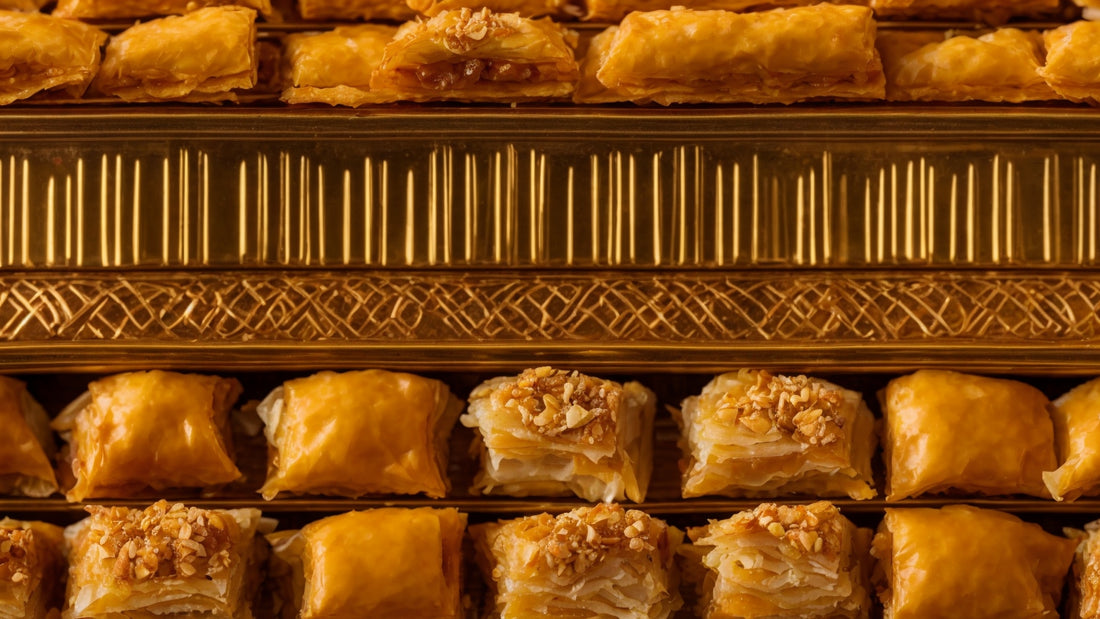
The Story of Baklava: A Journey Through Time and Cultures
Share
Baklava, or Baqlawa in Arabic, the honey-soaked, flaky pastry filled with nuts, is a dessert loved across the globe. But its history is as rich as its flavor, spanning centuries and connecting cultures. Let’s take a journey through the origins and evolution of this beloved treat, from ancient Persia to the modern-day tables around the world.
Ancient Roots: Tracing Baklava Back to Persia
While its exact origins remain debated, most culinary historians agree that baklava’s roots are in ancient Persia. The word “baqlawa,” believed to be Persian, hints at the pastry's early presence in the region. Early forms of baklava were simpler—thin sheets of dough layered with nuts and sweetened with honey, a precursor to the more elaborate versions we know today. Persian baklava was influenced by the culinary traditions of Mesopotamia and the Byzantine Empire, whose foods greatly shaped Persian cuisine.
The Byzantine Connection: A New Era for Baklava
As the Persian Empire expanded, its foods came into contact with the Byzantine Empire. The Byzantines introduced a game-changing ingredient: sugar. While honey had always been used, sugar brought a new sweetness to baklava. Byzantines also refined the technique of layering paper-thin dough sheets, giving baklava its signature crispy, flaky texture.
Ottoman Influence: Spreading Baklava’s Reach
When the Ottomans conquered much of the Byzantine Empire in the 15th century, baklava became a treasured dessert in their courts. The Ottomans introduced spices like cinnamon and cloves, and added new nuts like pistachios and walnuts, giving the dish an even richer flavor. Baklava quickly spread throughout the empire, from the kitchens of the wealthy to common folk’s homes. Its beauty and flavor made it a showstopper at celebrations and feasts.
A Global Journey: Baklava Across Cultures
As the Ottoman Empire expanded, so did baklava’s reach. It traveled to the Balkans, the Middle East, North Africa, and beyond, picking up local flavors and techniques along the way. In Greece, baklava became a national symbol, often made with honey and walnuts. In Turkey, pistachios became the star ingredient, while in Lebanon, orange blossom water added a fragrant twist. Each culture embraced baklava, making it their own, yet preserving its delicious essence.
Baqlawa Today: A Worldwide Favorite
Today, Baqlawa remains a dessert that transcends borders. Whether it’s the honey-drizzled Greek version or the pistachio-packed Turkish delight, Baqlawa has become a symbol of shared culinary heritage. Its layers of history are as complex as its flavors, making it a favorite in homes, bakeries, and restaurants across the globe.
Beyond Dessert: My Personal Connection to Baqlawa
More than just a treat, Baqlawa is a symbol of family, tradition, and hospitality. Personally, my favorite kind of Baqlawa is the one stuffed with walnuts. I love how buttery it tastes, melting in your mouth with each bite. I always make sure to have a delicious box of Baqlawa at home during Ramadan and Eid, and living in Kuwait, I’m lucky to be surrounded by amazing Baqlawa makers and varieties from all over the Arab world.
What's your favorite kind of Baqlawa?
Would you like me to make a video showing how to make walnut Baqlawa at home? Let me know in the comments below!
